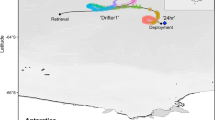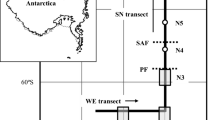Abstract
Anthropogenic inputs of CO2 are altering ocean chemistry and may alter the role of marine calcifiers in ocean ecosystems. Laboratory research and ocean models suggest calcifiers in polar waters are especially at risk, particularly pteropods: pelagic aragonite-shelled molluscs. However, baseline data for natural populations of pteropods are limited, especially for polar and sub-polar waters. In order to establish baseline data on diversity, preservation state and shell flux of in situ populations of Sub-Antarctic Southern Ocean pteropods, we deployed sediment traps above (1,000 m) and below (2,000 m) the aragonite saturation horizon (ASH) (currently at 1,200 m) from 1997 to 2006 at 47°S, 142°E. We identified seven pteropod taxa. We applied a shell opacity index to each shell collected and found 50% of shells collected above the ASH to be in pristine condition but only 3% of the shells collected below the ASH showed such a high degree of preservation. We estimated pteropod shell mass fluxes for the region (0.17–4.99 mg m−2 day−1), and we identified significant reductions in shell flux for Limacina helicina antarctica forma rangi and Clio recurva to the trap series above the ASH and for Limacina helicina antarctica forma rangi and Limacina helicina antarctica forma antarctica to the trap series below the ASH over the interval 1997–2006. Our data establish a temporal and vertical snapshot of the current Sub-Antarctic pelagic pteropod community and provide a baseline against which to monitor Southern Ocean pteropods responses, if any, to changing ocean conditions projected for the region in the coming decades.






Similar content being viewed by others
References
Accornero A, Manno C, Esposito F, Gambi MC (2003) The vertical flux of particulate matter in the polyna of Terra Nova Bay. Part II. Biological components. Antarct Sci 15:175–188
Anderson DR, Sweeney DJ, Williams TA (1981) Introduction to statistics—an applications approach. West Publishing Company, Minnesota
Bé AWH, Gilmer RW (1977) A zoographic and taxonomic review of euthecosomatous pteropoda. In: Ramsay ATS (ed) Oceanic micropalaeontology. Academic Press, London, pp 733–808
Belkin IM, Gordon AL (1996) Southern Ocean fronts from the Greenwich Meridian to Tasmania. J Geophys Res 101:3675–3696
Bray S, Trull T, Manganini S (2000) SAZ project moored sediment traps: results of the 1997–1998 deployments. Antarctic cooperative research centre report no. 15, Hobart, Tasmania, Australia
Byrne RH, Acker JG, Betzer PR, Feely RA, Cates MH (1984) Water column dissolution of aragonite in the Pacific Ocean. Nature 312:321–326
Collier R, Dymond J, Honjo SM, Francois R, Dunbar R (2000) The vertical flux of biogenic and lithogenic material in the Ross Sea: moored sediment trap observations 1996–1998. Deep Sea Res II 47:3491–3520
Comeau S, Gorsky G, Jeffree R, Teyssie JL, Gattuso JP (2009) Impact of ocean acidification on a key Arctic pelagic mollusc (Limacina helicina). Biogeosciences 6:1877–1882
Comeau S, Jeffree R, Teyssié JL, Gattuso JP (2010) Response of the Arctic pteropod Limacina helicina to projected future environmental conditions. Plos One. doi:10.1371/journal.pone.0011362
Dickson AG, Millero FJA (1987) Comparison of the equilibrium constants for the dissociation of carbonic acid in seawater media. Deep Sea Res 34:1733–1743
Fabry VJ (1989) Aragonite production by pteropod molluscs in the subarctic Pacific. Deep Sea Res 36:1735–1751
Fabry VJ, McClintock JB, Mathis JT, Grebmeier JM (2009) Ocean acidification at high latitudes: the bellwether. Oceanography 22:160–171
Feely PA, Sabine CL, Lee K, Berelson W, Kleypas J, Fabry VJ, Millero FJ (2004) Impact of anthropogenic CO2 on the CaCO3 system in the oceans. Science 305:362–366
Gannefors C, Böer M, Kattner G, Graeve M, Eiane K, Gulliksen B, Hop H, Falk-Petersen S (2005) The Arctic sea butterfly Limacina helicina: lipids and life strategy. Mar Biol 147:169–177
Gehlen M, Bassinot FC, Chou L, McCorkle D (2005) Reassessing the dissolution of marine carbonates: I. Solubility. Deep Sea Res I 52:1445–1460
Gerhardt S, Henrich R (2001) Shell preservation of Limacina inflata (Pteropoda) in surface sediments from the Central and South Atlantic Ocean: a new proxy to determine the aragonite saturation state of water masses. Deep Sea Res I 48:2051–2071
Gruber N, Gloor M, Mikaloff-Fletcher SE et al. (2009) Oceanic sources, sinks, and transport of atmospheric CO2. Glob. Biogeo Cyc. doi: 10.1029/2008GB003349
Harbison GR, Gilmer RW (1986) Effects of animal behaviour on sediment trap collections: implications for the calculations of aragonite fluxes. Deep Sea Res 33:1017–1024
Honjo S, Manganini SJ, Krishfield RA, Francois R (2008) Particulate organic carbon fluxes to the ocean interior and factors controlling the biological pump: a synthesis of global sediment trap programs since 1983. Prog Oceanog 76:217–285
Hopkins TL (1987) Midwater food web in McMurdo Sound, Ross Sea, Antarctica. Mar Biol 96:93–106
Hunt BPV, Pakhomov EA, Hosie GW, Siegel V, Ward P, Bernard K (2008) Pteropods in Southern Ocean ecosystems. Prog Oceanog 78:193–221
King AL, Howard WR (2003) Planktonic foraminiferal flux seasonality in subantarctic sediment traps: a test for paleoclimate reconstructions. Paleoceanography. doi:10.1029/2002PA000839
Lalli CM, Gilmer RW (1989) Pelagic snails: the biology of holoplanktonic gastropod mollusks. Stanford University Press, Stanford
Lewis E, Wallace DWR (1998) Program developed for CO2SYS system calculations. ORNL/CDIAC-105, Carbon Dioxide Information Analysis Center, Oak Ridge National Laboratory, U.S. Department of Energy, Oak Ridge
Manno C, Sandrini S, Tositti L, Accornero A (2007) First stages of degradation of Limacina helicina shells observed above the aragonite chemical lysocline in Terra Nova Bay (Antarctica). J Mar Sys 68:91–102
McNeil BI, Matear RJ (2008) Southern Ocean acidification: A tipping point at 450-ppm atmospheric CO2. P Natl Acad Sci USA 105(48):18860–18864
Mehrbach C, Culbertson CH, Hawley JE, Pytkowicz RM (1973) Measurement of the apparent dissociation constants of carbonic acid in seawater at atmospheric pressure. Lim Ocean 18:897–907
Meinecke G, Wefer G (1990) Seasonal pteropod sedimentation in the Norwegian Sea. Palaeogeog Palaeocl Palaeoecol 79:129–147
Metzl N, Tilbrook B, Poisson A (1999) The annual fCO2 cycle and the air-sea CO2 flux in the sub-Antarctic Ocean. Tellus B 51:849–861
Mucci A (1983) The solubility of calcite and aragonite in seawater at various salinities, temperatures, and one atmosphere total pressure. Am J Sci 283:780–799
Orr JC, Fabry VJ, Aumont O et al (2005) Anthropogenic ocean acidification over the twenty-first century and its impact on calcifying organisms. Nature 437:681–686
Rintoul SR, Bullister JL (1999) A late winter hydrographic section from Tasmania to Antarctica. Deep Sea Res I 46:1417–1454
Rintoul SR, Sokolov S (2001) Baroclinic transport variability of the Antarctic Circumpolar Current south of Australia (WOCE repeat section SR3). J Geophys Res 106:2795–2814
Sabine CL, Feely RA, Gruber N et al (2004) The oceanic sink for anthropogenic CO2. Science 305:367–371
Sea-viewing Wide Field-of-view Sensor (SeaWiFS) (2008) Global 9-km resolution data products, data access: GES-DISC interactive online visualization and analysis infrastructure, NASA Goddard earth sciences data and information services center http://reason.gsfc.nasa.gov/OPS/Giovanni/ocean.seawifs.2.shtml. Accessed 2010
Seibel BA, Dierssen HM (2003) Cascading trophic impacts of reduced biomass in the Ross Sea, Antarctica: just the tip of the iceberg? Biol Bull 205:93–97
Smith TM, Reynolds RW (2004) Improved extended reconstruction of SST (1854–1997) http://www.emc.ncep.noaa.gov/research/cmb/sst_analysis/. Accessed 2010
Sokolov S, Rintoul SR (2002) Structure of Southern Ocean fronts at 140°E. J Mar Sys 37:151–184
Tilbrook B, Rintoul S, Sabine C (2001) Carbon dioxide, hydrographic, and chemical data obtained during the R/V Aurora Australis Repeat Hydrography Cruise in the Southern Ocean: CLIVAR CO2 Repeat Section SR03_2001 (EXPOCODE AA0301), (29 October–22 November 2001). Carbon Dioxide Information Analysis Center, Oak Ridge National Laboratory, US Department of Energy, Oak Ridge, Tennessee. http://cdiac.ornl.gov/oceans/RepeatSections/clivar_p12.html. Accessed 2010
Trull T, Bray S, Manganini S, Honjo S, Francois R (2001) Moored sediment trap measurements of carbon export in the Sub-Antarctic and Polar Frontal zones of the Southern Ocean, south of Australia. J Geophys Res 106:31489–31510
van der Spoel S, Dadon JR (1999) Pteropoda. In: Boltovskoy D (ed) South Atlantic Zooplankton. Backhuys Publishers, The Netherlands, pp 649–706
van der Spoel S, Newman LJ, Estep KW (1997) Pelagic molluscs of the world: ETI world biodiversity CD-ROM series-version 1
Acknowledgments
This work was supported by the Australian Government through the Department of Climate Change and the Australian Cooperative Research Centres Program. The Australian Antarctic Division supports the ongoing sediment trap program (AAS # 1156). We thank Tas van Ommen and Simon Wotherspoon for statistical advice, discussions and critical review of the manuscript, two anonymous reviewers and Steve Comeau for critical reviews that significantly contributed to the final manuscript.
Author information
Authors and Affiliations
Corresponding author
Electronic supplementary material
Below is the link to the electronic supplementary material.
Rights and permissions
About this article
Cite this article
Roberts, D., Howard, W.R., Moy, A.D. et al. Interannual pteropod variability in sediment traps deployed above and below the aragonite saturation horizon in the Sub-Antarctic Southern Ocean. Polar Biol 34, 1739–1750 (2011). https://doi.org/10.1007/s00300-011-1024-z
Received:
Revised:
Accepted:
Published:
Issue Date:
DOI: https://doi.org/10.1007/s00300-011-1024-z




